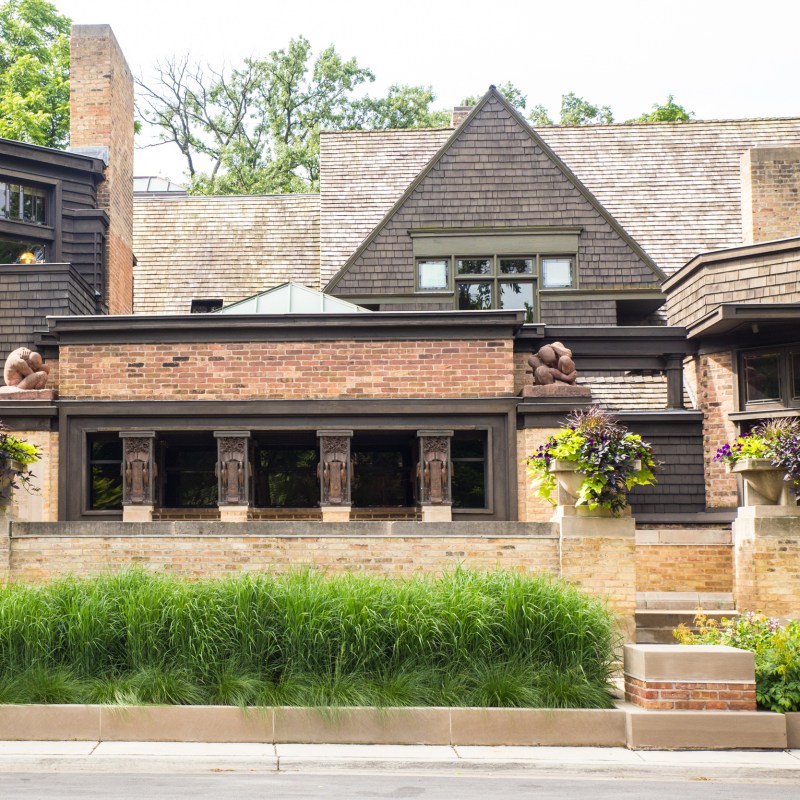
Famed architect Frank Lloyd Wright is recognized around the world for his bold, innovative designs and for his leadership in the Prairie School movement. Early in his career, he worked as an employee of the Sullivan and Adler architecture firm, with Louis Sullivan himself as his mentor. There he began to develop the elements that would later make him one of the most important architects of modern times. Exploring his architectural vision, Wright spent much of his time designing homes for the residents of Oak Park, Illinois, a suburb just west of Chicago. As a result, Oak Park holds a large and spectacular collection of Frank Lloyd Wright buildings. A visit to this charming village offers numerous iconic examples of Wright’s acclaimed work as well as insight into how he impacted the shape of modern architecture.
Videos by TravelAwaits

1. Unity Temple
Exhibiting a starkly modern structure when it was finished in 1908, the Unity Temple was Frank Lloyd Wright’s first major public building and remains one of his most prominent creations. A monolithic stone building from the exterior, the inside shines with natural lighting, geometric designs, and a sense of warmth and openness fitting for a place of contemplation and reflection. Wright designed the building for his own Unitarian Universalist congregation when their church was struck by lightning and burned down. Unity Temple has undergone a recent $25 million restoration and is an important location open to the public for guided tours, cultural performances, lectures, workshops, conferences, and community gatherings. Honored with status as a UNESCO World Heritage Site, Unity Temple remains an important and enduring masterpiece of architecture.

2. Frank Lloyd Wright Home And Studio
For many years, Frank Lloyd Wright occupied a personal home and studio in Oak Park, which he designed for himself and his family. He created the Frank Lloyd Wright Home and Studio with a loan he secured from his employer, the Sullivan and Adler architecture firm, in 1889. The architect spent the bulk of the next two decades designing over 150 projects from this location. Inspired by ideas from transcendentalists like Ralph Waldo Emerson and Henry David Thoreau, Wright made architectural designs that reflect a desire to live in harmony with nature. Visitors can take a guided home and studio tour to explore the unique interior and learn more about the genius that is such a prominent figure not only in Oak Park but also in the history of American architecture.

3. Robert Parker House
As an employee of Sullivan and Adler, Wright was prohibited from competing with them by taking independent commissions. Nevertheless, he did, resulting in the infamous “bootleg” homes that he designed on the side until his boss, Louis Sullivan, discovered what he was doing and ultimately fired him. The Robert Parker House built in 1892 is a great way to see Wright developing his style as an architect. It’s small and cost-effective but embodies the influence of his mentor Sullivan through a philosophy of geometric simplicity. Wright would further evolve this approach as the Prairie School movement took root. The stylistic differences between Wright’s design are even more visible when contrasted with the more traditional surrounding homes, which were so popular at the time. While the Parker House is best described as transitional in nature, it is a vivid example of the developing architect as he began to follow his own design path.
4. Walter Gale House
While the Walter Gale House has much in common with Wright’s bootleg homes, it was actually one of his first legitimate independent commissions after parting ways with Sullivan and Adler in 1893. The house maintains some of the popular Queen Anne features of the day, but its geometric simplicity and use of contiguous curved windows with diamond-paned leaded glass show his unconventional approach. Designed for Walter Gale, the home features architectural details such as wood panels and beamed ceilings that would make their way into Wright’s later designs.

5. Arthur Heurtley House
Recognized by many as one of the most important and greatest residential architectural accomplishments of Frank Lloyd Wright’s illustrious career, the 1902 Arthur Heurtley House clearly displays the Prairie style elements that Wright evolved into the Prairie School movement, ultimately becoming a preeminent brand of architectural design. Though a bit flashier than his later works, Wright aptly built the Heurtley House for a banker who loved art, music, and entertainment. The variegated brickwork adds texture and color while the horizontal form enhances the home’s relation to the surrounding environment. A large arched fireplace mimics the building’s exterior arch while lead glass windows expose main living areas to lots of light. French doors in the living room open onto an elevated porch, merging interior and exterior into one continuous space. Wright’s advancing devotion to creating architecture that blended in with the landscape rather than standing out makes a strong presence in this eloquent expression.

6. E. R. And Mary Hills House
Though this home was originally built several years earlier as a gift for the daughter of a successful writer and publisher, Wright was commissioned to remodel the E.R. and Mary Hills House in 1900. The home was repositioned and extensively remodeled, with Wright employing his now recognizable Prairie School style throughout the home. Unique passageways, distinct room orientations, and significant expansions created a space that Wright filled with Prairie-style elements such as large Roman brick fireplaces, oak radiator covers, built-in furnishings, and oak floors and surfaces throughout. Wright’s growing affinity for Japanese style appears primarily in the roof design, which is reminiscent of the Asian pagoda. These elements combined with the horizontal orientation of the house make it an interesting and unique example of Wright’s influences. Though this home is now a private residence that does not offer tours, it is well worth visiting to enjoy the exterior, which is an important example of Wright’s finest works.
7. Laura Robeson Gale House
The first of Wright’s houses to incorporate the arresting example of cantilevered design, the Laura Robeson Gale House holds significance in the development of the architect’s future plans. It’s a strong example of Prairie-style sensibilities, but also provides a glimpse of the elements Wright later used to create his landmark accomplishment, Fallingwater in Southern Pennsylvania. Laura Gale was the widow of Thomas Gale, who had commissioned two of Wright’s earlier “bootleg” houses. She hired Wright in 1909 to design this home for herself and her children. The distinctive flat roofline and low-slung ceilings immediately impress with Wright’s signature design. Add a large stone fireplace and art glass windows, and the Prairie style comes to life in one of Wright’s most unique and memorable Oak Park homes.

8. Oscar B. Balch House
While Frank Lloyd Wright is revered for his architectural contributions, his personal life is a lot less admired. Though married with children, Wright romanced the wife of one of his clients, who also had children. The two of them abandoned their families and made a temporary escape to Germany, causing much ridicule for both of them. The Oscar B. Balch House was his first commission after returning to the United States in 1911. A striking example of Wright’s now mature Prairie design, the house features a flat roof, overhanging eaves, geometric and linear proportions, a heightened terrace, and an obscured entrance that emphasizes a sense of retreat from the outside world. It may evoke a domestic fortress, perhaps a reflection of Wright’s mental and emotional landscape at the time.
9. Harry S. Adams House
The last residence that Frank Lloyd Wright designed for Oak Park is the Harry S. Adams House. Built in 1913, it is a fitting finale for his Prairie School movement, summoning all the elements in an exquisite composition. The horizontal orientation, terraced wall, flat roof, contiguous windows, wide eaves, and beautiful stained glass elements are fully on display. Interestingly, Wright had produced two prior sets of plans for the house, which Adams had rejected as too elaborate. When Adams went to a competitor who created a simpler drawing, Wright became furious and drafted a streamlined final plan using his mature Prairie style of expansive horizontal lines and forms, which Adams accepted. There is no finer example of the purity of Wright’s Prairie style houses, which makes this a fitting finale for his Oak Park phase. Wright’s contribution to the historic character of the neighborhood is also a treasure to the architectural world.
Oak Park is unique for both the number and quality of Frank Lloyd Wright creations available to explore. We would suggest going in a season other than winter so you can see the buildings and their surroundings as completely as possible. There are various guided and self-guided tours, including those on foot or by bicycle. While in Oak Park, take time to explore the rest of the village. Its delightful shops, delicious restaurants, unique arts district, and plentiful street art make it a wonderful place to spend the day or weekend. If you’re in Chicago and want to see more of the surrounding area, check out our list of the best day trips from Chicago!
